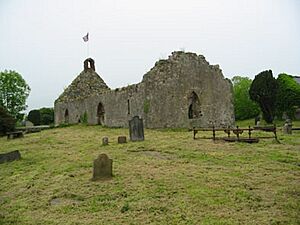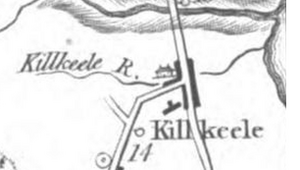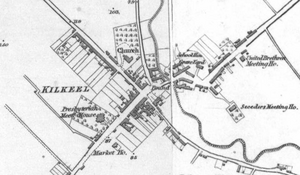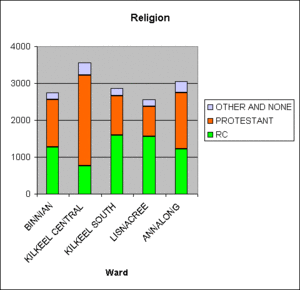Kilkeel facts for kids
Quick facts for kids Kilkeel
|
|
|---|---|
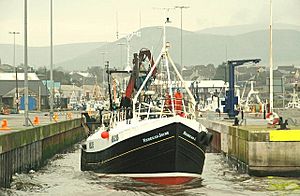 Kilkeel Harbour and Mourne Mountains |
|
| Population | 6,633 (2021 census) |
| District |
|
| County | |
| Country | Northern Ireland |
| Sovereign state | United Kingdom |
| Post town | NEWRY |
| Postcode district | BT34 |
| Dialling code | 028 |
| Police | Northern Ireland |
| Fire | Northern Ireland |
| Ambulance | Northern Ireland |
| EU Parliament | Northern Ireland |
| UK Parliament |
|
| NI Assembly |
|
Kilkeel is a small town in County Down, Northern Ireland. Its name comes from the Irish words 'Cill Chaoil', which mean "church of the narrow place". Kilkeel is the most southern town in Northern Ireland. It is part of the historic area called the barony of Mourne.
Kilkeel is known as the main fishing port on the Down coast. Its harbour is home to the biggest fishing fleet in Northern Ireland. In 2021, about 6,633 people lived there. The town has the old remains of a church and a fort from the 1300s. It also has winding streets and shops. Kilkeel is located just south of the beautiful Mourne Mountains.
Contents
Exploring Kilkeel's Location
Kilkeel town is built on a flat area of land south of the Mourne Mountains. It is west of where the Kilkeel River flows south into the North Channel. The town's main part is in an area called Magheramurphy. This name means "Murphy's plain" in Irish.
Kilkeel also spreads into other nearby areas, which are called townlands. These include:
- Derryoge (meaning "Ríog's oak wood")
- Drumcro (meaning "ridge of the fold or enclosure")
- Dunnaman
- Kilkeel (meaning "church of the narrow place")
There are 69 townlands in total in the wider Kilkeel area.
Kilkeel's Past: A Look Back
Where Did the Name Kilkeel Come From?
The name Kilkeel comes from an old church that stands above the town. It is an English version of the Irish name 'Cill Chaoil'. This means "church narrow". The name might describe the church itself, or it could mean the church was built on a narrow piece of land between two rivers, the Aughrim and Kilkeel rivers.
The church was built in 1388. It was dedicated to "St Colman Del Mourne". Even though few people lived in Kilkeel during the Middle Ages, this church was thought to be very important. People have known about Kilkeel as a Christian settlement since the 1000s. The church was rebuilt in the 1600s. Later, in the 1800s, it was used as a school before being left empty.
The graveyard next to the church was used for burials until 1916. The last people buried there were victims of a ship crash. Two large steamers, the Retriever and the SS Connemara, crashed in Carlingford Lough.
The Aughrim river divides the town. The northern part of Kilkeel is in the Kilkeel townland, and the southern part is in Magheramurphy.
How Kilkeel Grew Over Time
Kilkeel was not a town in the early 1600s. It slowly grew from a small village into a town by the late 1700s. The oldest known dates found in the town are from a stone curb marked 1772 and a window arch from 1790. A map from 1777 shows that Kilkeel already had its current layout of five main streets.
The number of people living in Kilkeel reached its highest point, about 15,000, during the time of the Great Famine. After this, the population dropped to about 11,000, with around 1,000 people living in Kilkeel town itself.
What Drives Kilkeel's Economy?
Fishing: A Key Industry
Fishing is a very important business in Kilkeel. Kilkeel Harbour is the main port for the largest fishing fleet in Northern Ireland. This means many fishing boats call Kilkeel their home. Around the port, there are factories that process fish. People also enjoy fishing for fun off the piers. Along the coast, there is even lobster farming.
Other Major Employers
In the early 2000s, a company called Collins Aerospace became the biggest employer in the area. This company used to be known as BE Aerospace and Rockwell Collins. As of 2014, their factory in Kilkeel made seats for airplanes that were sold all over the world. More than 800 people worked there.
Notable People and Titles
Prince Harry, Duke of Sussex, who is the grandson of the late Queen Elizabeth II and son of King Charles III, was given a special title. When he married Meghan Markle in 2018, he was made Baron Kilkeel. This title is named after the town of Kilkeel. He also received the titles of Duke of Sussex and Earl of Dumbarton.
Who Lives in Kilkeel? (Demographics)
Kilkeel's Population in 2011
On March 27, 2011, the census showed that 6,541 people lived in Kilkeel. This was about 2,557 households.
- About 21% of the people were under 16 years old, and about 15% were 65 or older.
- Slightly more than half (about 51%) of the people were female, and about 48% were male.
- About 54% of people were raised as Protestants, and about 41% were raised as Catholics.
- When asked about their national identity, about 55% said they felt British, 28% felt Northern Irish, and 20% felt Irish. People could choose more than one identity.
- The average age of people in Kilkeel was 35 years.
- About 9% of people knew some Ulster-Scots, and about 9% knew some Irish.
Kilkeel's Population in 2021
On March 21, 2021, the census showed that 6,633 people lived in Kilkeel.
- About 51% of people were raised as Protestants, and about 41% were raised as Catholics.
- About 49% said they felt British, 32% felt Northern Irish, and 24% felt Irish. Again, people could choose more than one identity.
Religious Backgrounds in Kilkeel
In 1659, most people in Kilkeel (80%) were Catholic. By 1901, this number had dropped to half. Of the remaining population, 60% were Presbyterians, and most of the rest belonged to the Church of Ireland.
Learning in Kilkeel (Education)
Kilkeel has several schools for children of different ages:
- St Colman's Primary School
- Brackenagh West Primary School
- Grange Primary School
- Holy Cross Primary School
- Gaelscoil na mBeann is a special primary school. It teaches mostly in the Irish language, and English is introduced later. It follows the Northern Ireland curriculum. This school started in 2010 because local parents wanted their children to learn through Irish. It received official recognition and funding in 2012.
- Kilkeel High School
- Kilkeel Primary School
- St. Louis High School
- Mourne Grange Village School
- Mourne Independent Christian School
- St Colombans Primary School
Sports and Activities in Kilkeel
Many different sports are popular in the Kilkeel area. These include Gaelic football, football, hockey, fishing, golf, hurling, and swimming.
There are five Gaelic Athletic Association (GAA) clubs nearby: An Ríocht, Longstone, Atticall, Ballymartin, and Glasdrumman. These clubs have bars, sports facilities, and host community events. In 2023, these five clubs joined together to form the Clann Mhúrn (meaning "people of Mourne") Hurling club. They practice and play at the different club facilities.
The most senior association football team is Valley Rangers Football Club. They play in the Mid-Ulster Football League. Other local football teams include Ballyvea FC, Dunnaman FC, and Mourne Rovers.
Kilkeel Hockey Club plays at McAuley Park. It is the only hockey club in the Mourne area.
There is also a golf course at Kilkeel Golf Club. Fairways Golf, an indoor golf simulator, opened in 2023.
|
See also
 In Spanish: Kilkeel para niños
In Spanish: Kilkeel para niños



